AYB200 S1 2019 Financial Accounting: Business Report Analysis
VerifiedAdded on 2023/01/16
|10
|1604
|59
Report
AI Summary
This report provides a detailed financial analysis of Greenmount Ltd, an ASX-listed company considering expanding into the fashion business through acquisitions. The report begins with an executive summary and table of contents, followed by an introduction outlining Greenmount Ltd's goals and the identification of two potential acquisition targets: Tallows Ltd and Bilgola Ltd. The core of the analysis involves computing the net asset value of both target companies, using fair value accounting principles as outlined in AASB 13 and IFRS 13. The report then contrasts fair value accounting with historical cost accounting, presenting arguments for and against each method. The conclusion synthesizes the findings and recommends that Greenmount Ltd acquire Bilgola Ltd based on its higher net asset value and favorable plant, property, and equipment life. The report references relevant accounting standards and academic literature to support its analysis and recommendations.
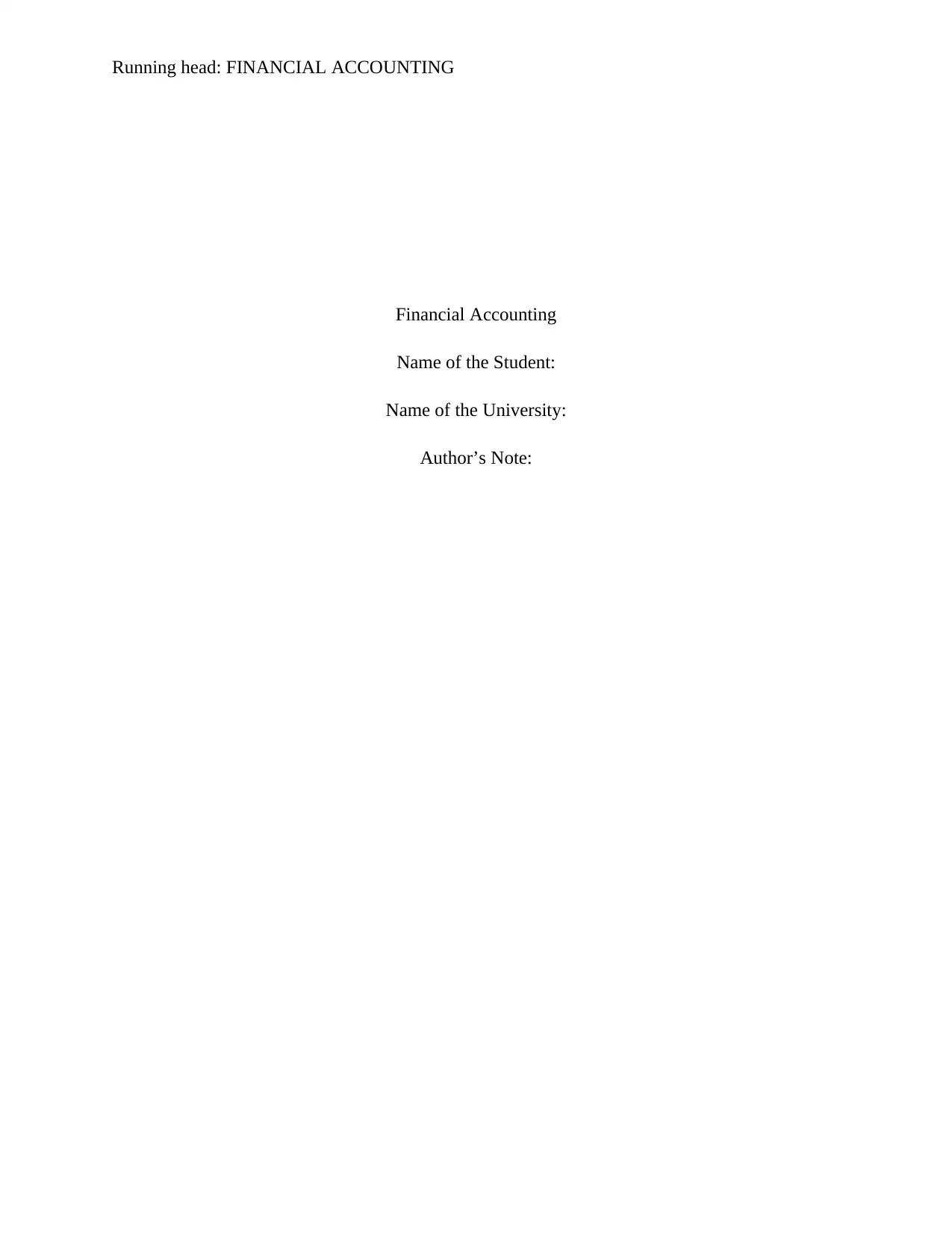
Running head: FINANCIAL ACCOUNTING
Financial Accounting
Name of the Student:
Name of the University:
Author’s Note:
Financial Accounting
Name of the Student:
Name of the University:
Author’s Note:
Paraphrase This Document
Need a fresh take? Get an instant paraphrase of this document with our AI Paraphraser
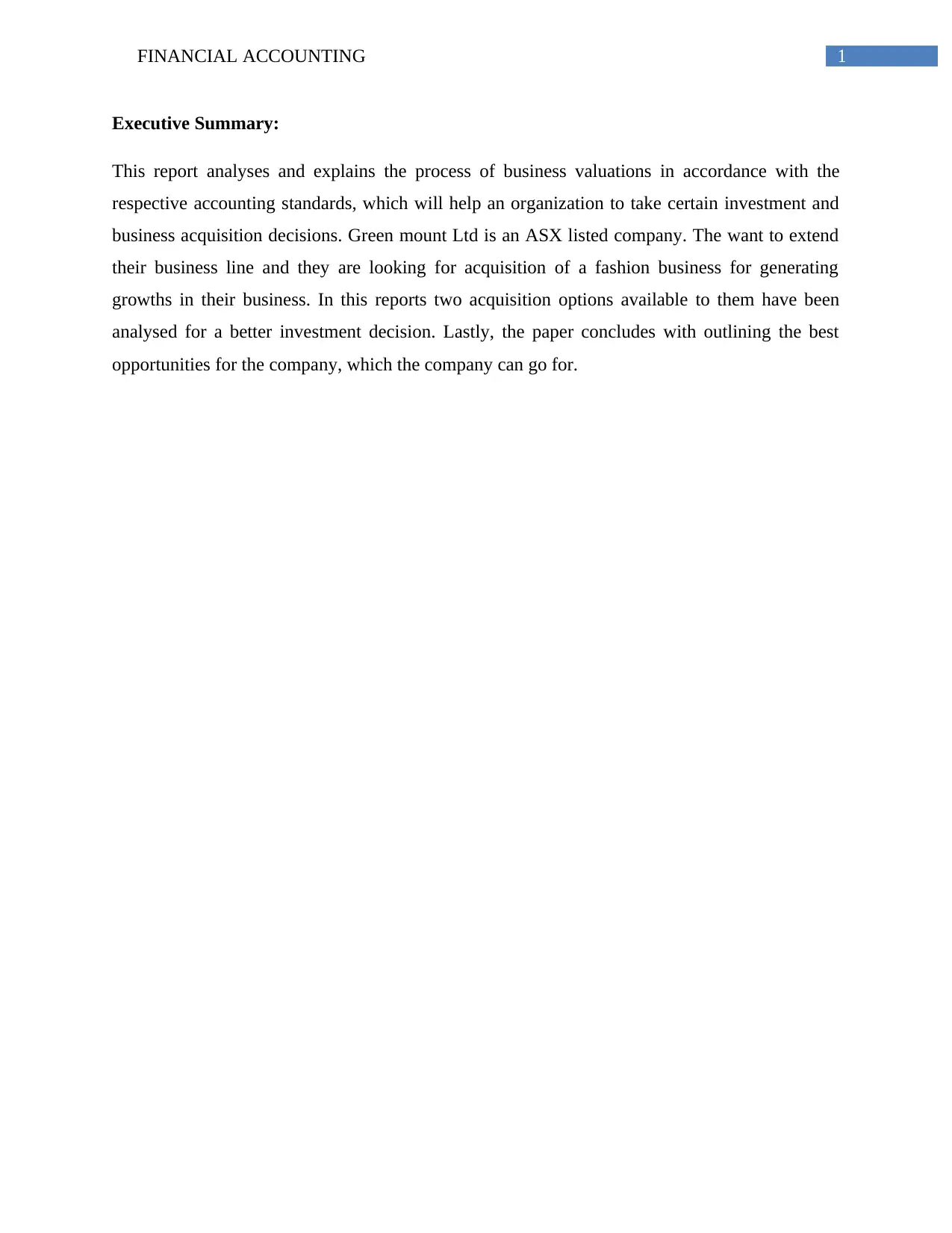
1FINANCIAL ACCOUNTING
Executive Summary:
This report analyses and explains the process of business valuations in accordance with the
respective accounting standards, which will help an organization to take certain investment and
business acquisition decisions. Green mount Ltd is an ASX listed company. The want to extend
their business line and they are looking for acquisition of a fashion business for generating
growths in their business. In this reports two acquisition options available to them have been
analysed for a better investment decision. Lastly, the paper concludes with outlining the best
opportunities for the company, which the company can go for.
Executive Summary:
This report analyses and explains the process of business valuations in accordance with the
respective accounting standards, which will help an organization to take certain investment and
business acquisition decisions. Green mount Ltd is an ASX listed company. The want to extend
their business line and they are looking for acquisition of a fashion business for generating
growths in their business. In this reports two acquisition options available to them have been
analysed for a better investment decision. Lastly, the paper concludes with outlining the best
opportunities for the company, which the company can go for.

2FINANCIAL ACCOUNTING
Table of Contents
Introduction:....................................................................................................................................3
Computation of Net Assets Value of the target companies:............................................................3
Net Assets Value of Tallows Ltd:................................................................................................3
Net Assets Value of Bilgola Ltd:.................................................................................................5
Fair Value accounting Vs Historical cost accounting:....................................................................6
Arguments in favour of Historical cost accounting concept:......................................................6
Arguments against Historical cost accounting concept:..............................................................7
Arguments in favour of Fair value accounting system:...............................................................7
Arguments against the Fair value accounting concept:...............................................................7
Conclusion:......................................................................................................................................7
Recommendations:..........................................................................................................................7
References and bibliography:..........................................................................................................9
Table of Contents
Introduction:....................................................................................................................................3
Computation of Net Assets Value of the target companies:............................................................3
Net Assets Value of Tallows Ltd:................................................................................................3
Net Assets Value of Bilgola Ltd:.................................................................................................5
Fair Value accounting Vs Historical cost accounting:....................................................................6
Arguments in favour of Historical cost accounting concept:......................................................6
Arguments against Historical cost accounting concept:..............................................................7
Arguments in favour of Fair value accounting system:...............................................................7
Arguments against the Fair value accounting concept:...............................................................7
Conclusion:......................................................................................................................................7
Recommendations:..........................................................................................................................7
References and bibliography:..........................................................................................................9
⊘ This is a preview!⊘
Do you want full access?
Subscribe today to unlock all pages.

Trusted by 1+ million students worldwide
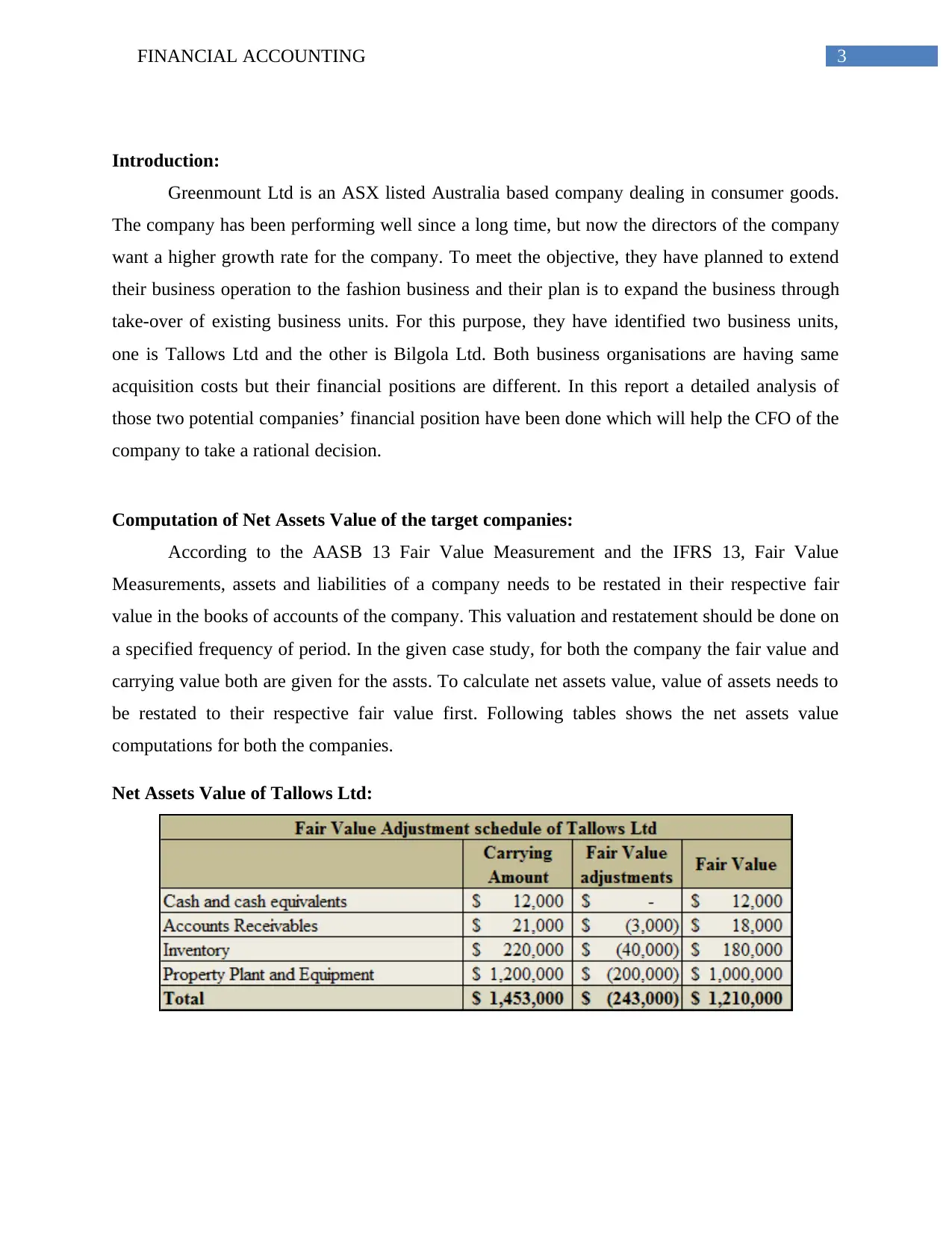
3FINANCIAL ACCOUNTING
Introduction:
Greenmount Ltd is an ASX listed Australia based company dealing in consumer goods.
The company has been performing well since a long time, but now the directors of the company
want a higher growth rate for the company. To meet the objective, they have planned to extend
their business operation to the fashion business and their plan is to expand the business through
take-over of existing business units. For this purpose, they have identified two business units,
one is Tallows Ltd and the other is Bilgola Ltd. Both business organisations are having same
acquisition costs but their financial positions are different. In this report a detailed analysis of
those two potential companies’ financial position have been done which will help the CFO of the
company to take a rational decision.
Computation of Net Assets Value of the target companies:
According to the AASB 13 Fair Value Measurement and the IFRS 13, Fair Value
Measurements, assets and liabilities of a company needs to be restated in their respective fair
value in the books of accounts of the company. This valuation and restatement should be done on
a specified frequency of period. In the given case study, for both the company the fair value and
carrying value both are given for the assts. To calculate net assets value, value of assets needs to
be restated to their respective fair value first. Following tables shows the net assets value
computations for both the companies.
Net Assets Value of Tallows Ltd:
Introduction:
Greenmount Ltd is an ASX listed Australia based company dealing in consumer goods.
The company has been performing well since a long time, but now the directors of the company
want a higher growth rate for the company. To meet the objective, they have planned to extend
their business operation to the fashion business and their plan is to expand the business through
take-over of existing business units. For this purpose, they have identified two business units,
one is Tallows Ltd and the other is Bilgola Ltd. Both business organisations are having same
acquisition costs but their financial positions are different. In this report a detailed analysis of
those two potential companies’ financial position have been done which will help the CFO of the
company to take a rational decision.
Computation of Net Assets Value of the target companies:
According to the AASB 13 Fair Value Measurement and the IFRS 13, Fair Value
Measurements, assets and liabilities of a company needs to be restated in their respective fair
value in the books of accounts of the company. This valuation and restatement should be done on
a specified frequency of period. In the given case study, for both the company the fair value and
carrying value both are given for the assts. To calculate net assets value, value of assets needs to
be restated to their respective fair value first. Following tables shows the net assets value
computations for both the companies.
Net Assets Value of Tallows Ltd:
Paraphrase This Document
Need a fresh take? Get an instant paraphrase of this document with our AI Paraphraser
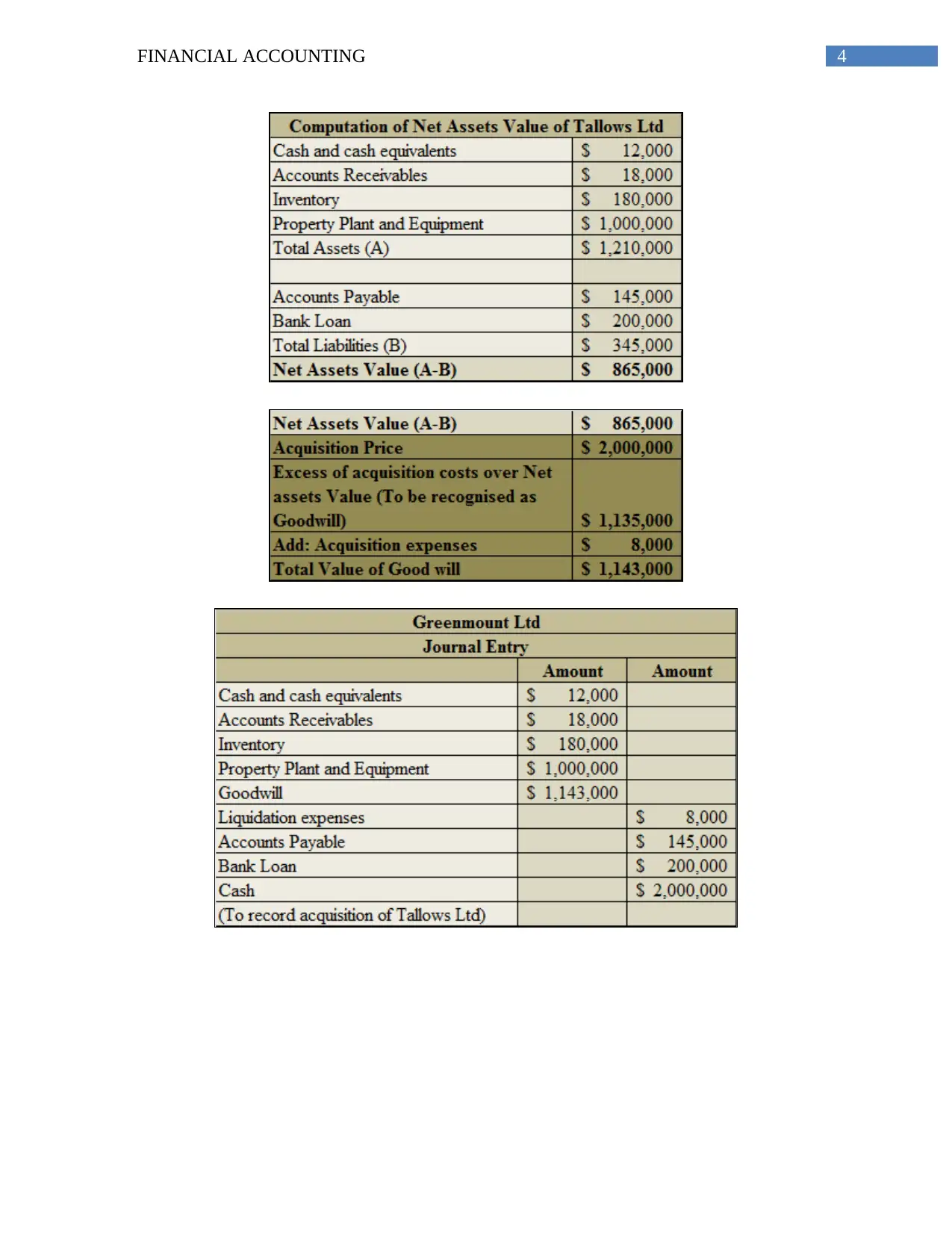
4FINANCIAL ACCOUNTING
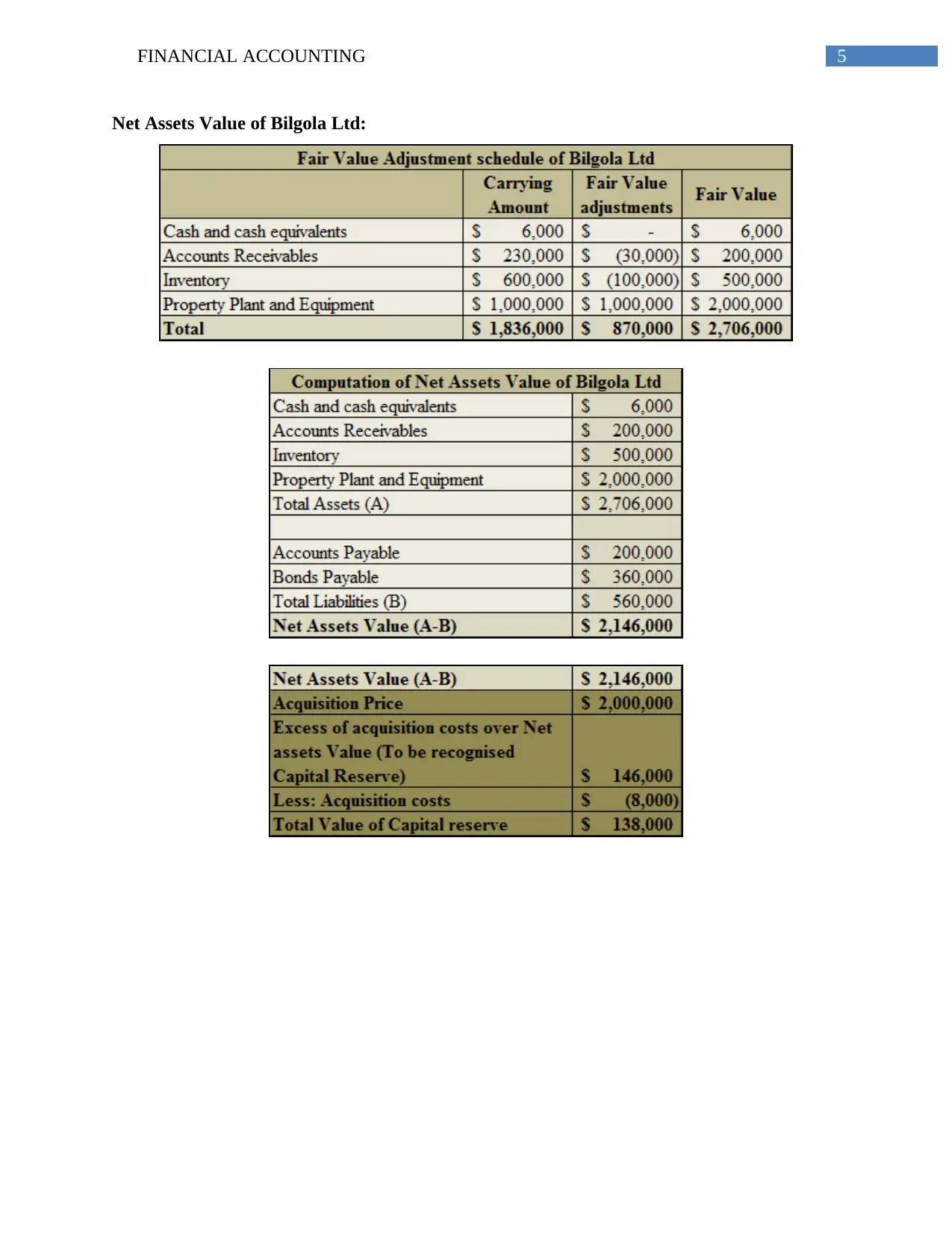
5FINANCIAL ACCOUNTING
Net Assets Value of Bilgola Ltd:
Net Assets Value of Bilgola Ltd:
⊘ This is a preview!⊘
Do you want full access?
Subscribe today to unlock all pages.

Trusted by 1+ million students worldwide

6FINANCIAL ACCOUNTING
Fair Value accounting Vs Historical cost accounting:
Historical cost accounting is a traditional concept of accounting, which requires that
every transaction to be recorded in the historical cost in the books of accounts. Under this
concept, assets are recorded in the books of accounts at their historical costs and the same
amount is carried forward subject to depreciation. This system of accounting is very easy to
implement and it can be followed easily. On the other hand, the fair value concept of accounting
requires the assets and liabilities to be restated in the books of accounts in their current market
value. The AASB 13 and the new IFRS 13 provides the guidelines and principles for revaluation
of assets and liabilities in the books of accounts at their respective fair value (AASB 13, 2015).
Some authors and corporatists considers the historical cost accounting system to be better
rather that the fair value accounting and some of them argues that the fair value accounting
system is superior than the historical cost accounting system. In the following paragraphs, some
of such arguments in favour and against those two concepts have been described briefly.
Arguments in favour of Historical cost accounting concept:
Historical cost accounting concepts have been very popular since a long time and it is
being used widely by most of the business organisations. Its popularity is because of its
simpleness and easy to implementation. It does not require highly expertise knowledge to
implement and operate, rather its implementation is very easy and cost efficient. Though the
system is a traditional system, it is very easy and useful for the business organisations.
Fair Value accounting Vs Historical cost accounting:
Historical cost accounting is a traditional concept of accounting, which requires that
every transaction to be recorded in the historical cost in the books of accounts. Under this
concept, assets are recorded in the books of accounts at their historical costs and the same
amount is carried forward subject to depreciation. This system of accounting is very easy to
implement and it can be followed easily. On the other hand, the fair value concept of accounting
requires the assets and liabilities to be restated in the books of accounts in their current market
value. The AASB 13 and the new IFRS 13 provides the guidelines and principles for revaluation
of assets and liabilities in the books of accounts at their respective fair value (AASB 13, 2015).
Some authors and corporatists considers the historical cost accounting system to be better
rather that the fair value accounting and some of them argues that the fair value accounting
system is superior than the historical cost accounting system. In the following paragraphs, some
of such arguments in favour and against those two concepts have been described briefly.
Arguments in favour of Historical cost accounting concept:
Historical cost accounting concepts have been very popular since a long time and it is
being used widely by most of the business organisations. Its popularity is because of its
simpleness and easy to implementation. It does not require highly expertise knowledge to
implement and operate, rather its implementation is very easy and cost efficient. Though the
system is a traditional system, it is very easy and useful for the business organisations.
Paraphrase This Document
Need a fresh take? Get an instant paraphrase of this document with our AI Paraphraser
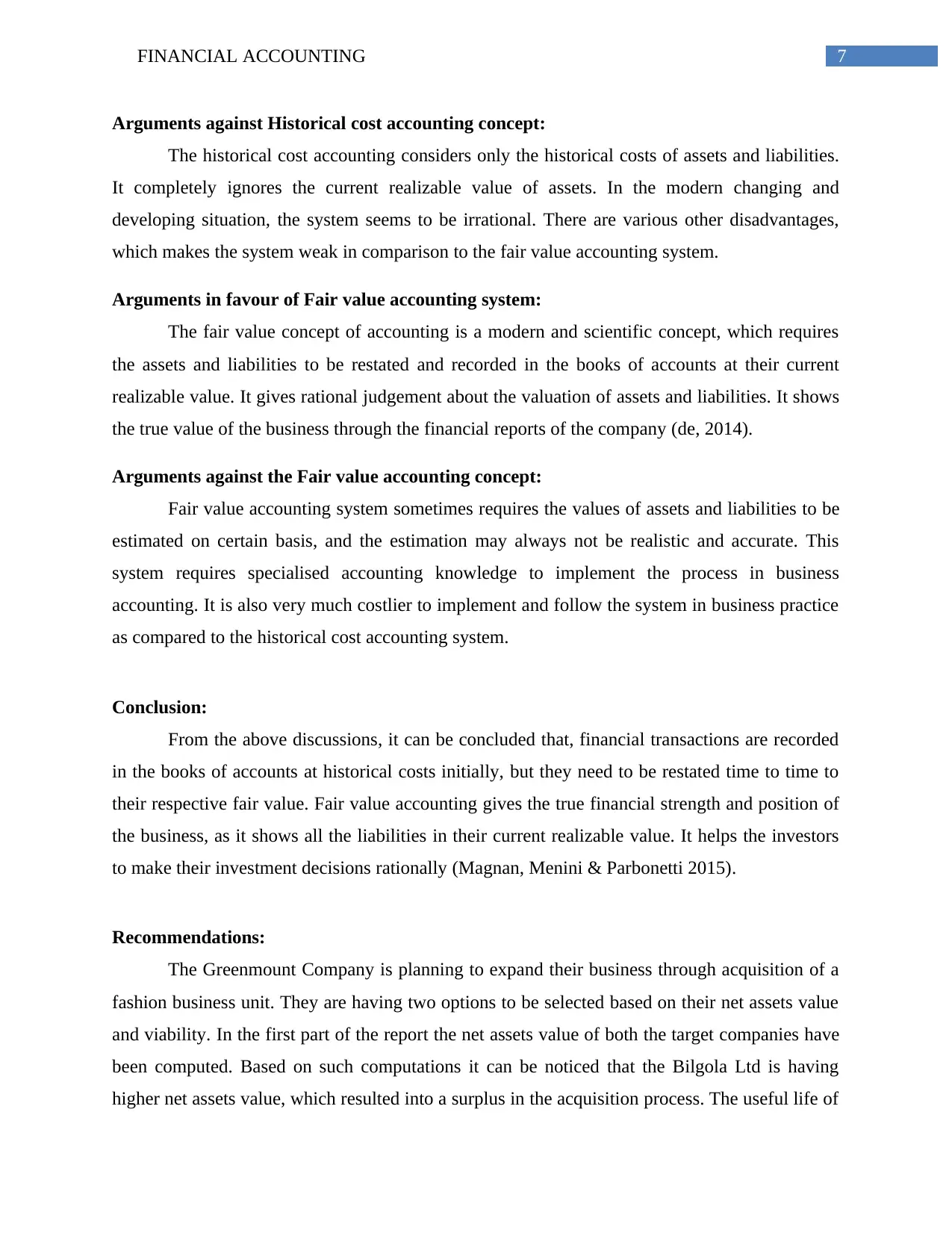
7FINANCIAL ACCOUNTING
Arguments against Historical cost accounting concept:
The historical cost accounting considers only the historical costs of assets and liabilities.
It completely ignores the current realizable value of assets. In the modern changing and
developing situation, the system seems to be irrational. There are various other disadvantages,
which makes the system weak in comparison to the fair value accounting system.
Arguments in favour of Fair value accounting system:
The fair value concept of accounting is a modern and scientific concept, which requires
the assets and liabilities to be restated and recorded in the books of accounts at their current
realizable value. It gives rational judgement about the valuation of assets and liabilities. It shows
the true value of the business through the financial reports of the company (de, 2014).
Arguments against the Fair value accounting concept:
Fair value accounting system sometimes requires the values of assets and liabilities to be
estimated on certain basis, and the estimation may always not be realistic and accurate. This
system requires specialised accounting knowledge to implement the process in business
accounting. It is also very much costlier to implement and follow the system in business practice
as compared to the historical cost accounting system.
Conclusion:
From the above discussions, it can be concluded that, financial transactions are recorded
in the books of accounts at historical costs initially, but they need to be restated time to time to
their respective fair value. Fair value accounting gives the true financial strength and position of
the business, as it shows all the liabilities in their current realizable value. It helps the investors
to make their investment decisions rationally (Magnan, Menini & Parbonetti 2015).
Recommendations:
The Greenmount Company is planning to expand their business through acquisition of a
fashion business unit. They are having two options to be selected based on their net assets value
and viability. In the first part of the report the net assets value of both the target companies have
been computed. Based on such computations it can be noticed that the Bilgola Ltd is having
higher net assets value, which resulted into a surplus in the acquisition process. The useful life of
Arguments against Historical cost accounting concept:
The historical cost accounting considers only the historical costs of assets and liabilities.
It completely ignores the current realizable value of assets. In the modern changing and
developing situation, the system seems to be irrational. There are various other disadvantages,
which makes the system weak in comparison to the fair value accounting system.
Arguments in favour of Fair value accounting system:
The fair value concept of accounting is a modern and scientific concept, which requires
the assets and liabilities to be restated and recorded in the books of accounts at their current
realizable value. It gives rational judgement about the valuation of assets and liabilities. It shows
the true value of the business through the financial reports of the company (de, 2014).
Arguments against the Fair value accounting concept:
Fair value accounting system sometimes requires the values of assets and liabilities to be
estimated on certain basis, and the estimation may always not be realistic and accurate. This
system requires specialised accounting knowledge to implement the process in business
accounting. It is also very much costlier to implement and follow the system in business practice
as compared to the historical cost accounting system.
Conclusion:
From the above discussions, it can be concluded that, financial transactions are recorded
in the books of accounts at historical costs initially, but they need to be restated time to time to
their respective fair value. Fair value accounting gives the true financial strength and position of
the business, as it shows all the liabilities in their current realizable value. It helps the investors
to make their investment decisions rationally (Magnan, Menini & Parbonetti 2015).
Recommendations:
The Greenmount Company is planning to expand their business through acquisition of a
fashion business unit. They are having two options to be selected based on their net assets value
and viability. In the first part of the report the net assets value of both the target companies have
been computed. Based on such computations it can be noticed that the Bilgola Ltd is having
higher net assets value, which resulted into a surplus in the acquisition process. The useful life of
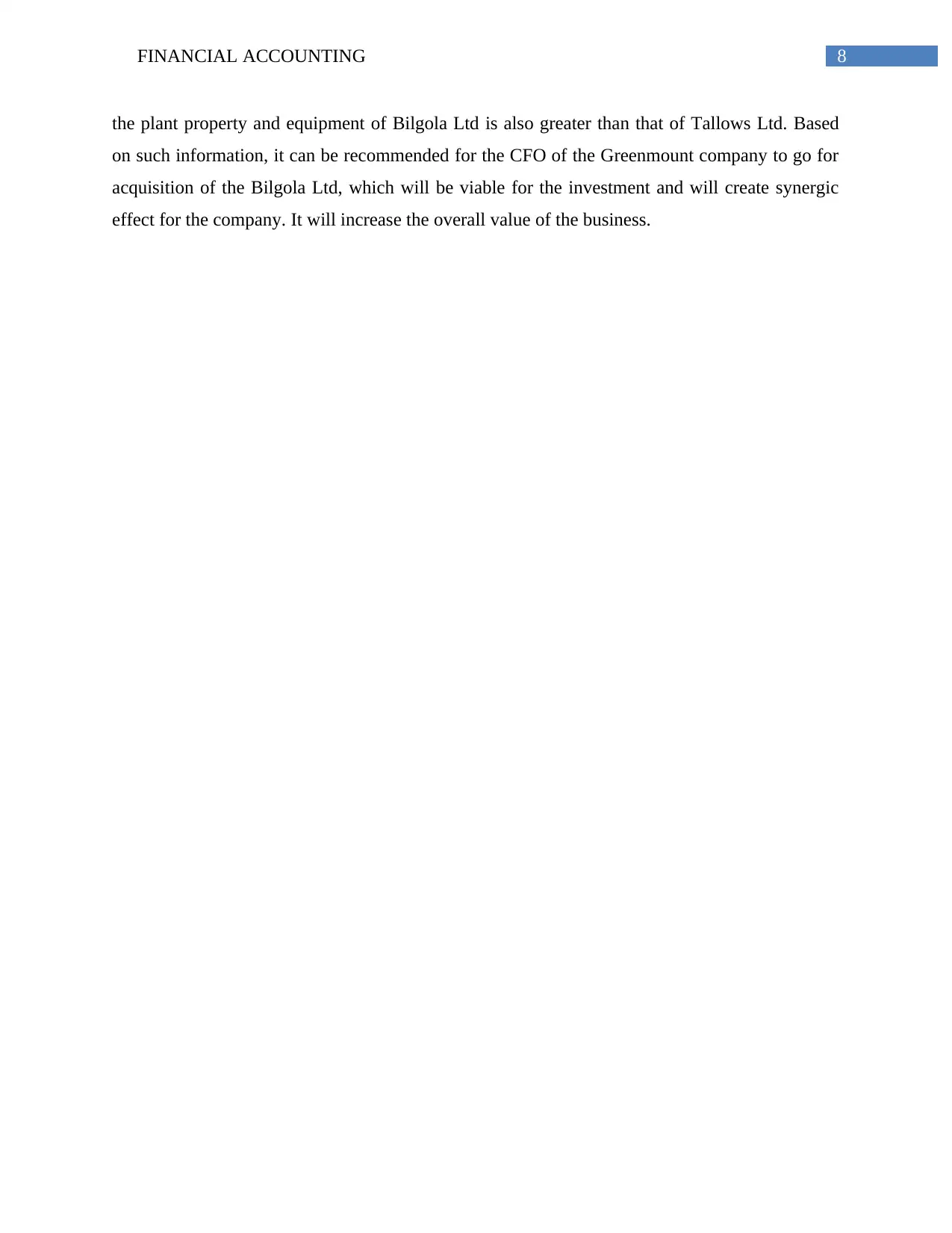
8FINANCIAL ACCOUNTING
the plant property and equipment of Bilgola Ltd is also greater than that of Tallows Ltd. Based
on such information, it can be recommended for the CFO of the Greenmount company to go for
acquisition of the Bilgola Ltd, which will be viable for the investment and will create synergic
effect for the company. It will increase the overall value of the business.
the plant property and equipment of Bilgola Ltd is also greater than that of Tallows Ltd. Based
on such information, it can be recommended for the CFO of the Greenmount company to go for
acquisition of the Bilgola Ltd, which will be viable for the investment and will create synergic
effect for the company. It will increase the overall value of the business.
⊘ This is a preview!⊘
Do you want full access?
Subscribe today to unlock all pages.

Trusted by 1+ million students worldwide
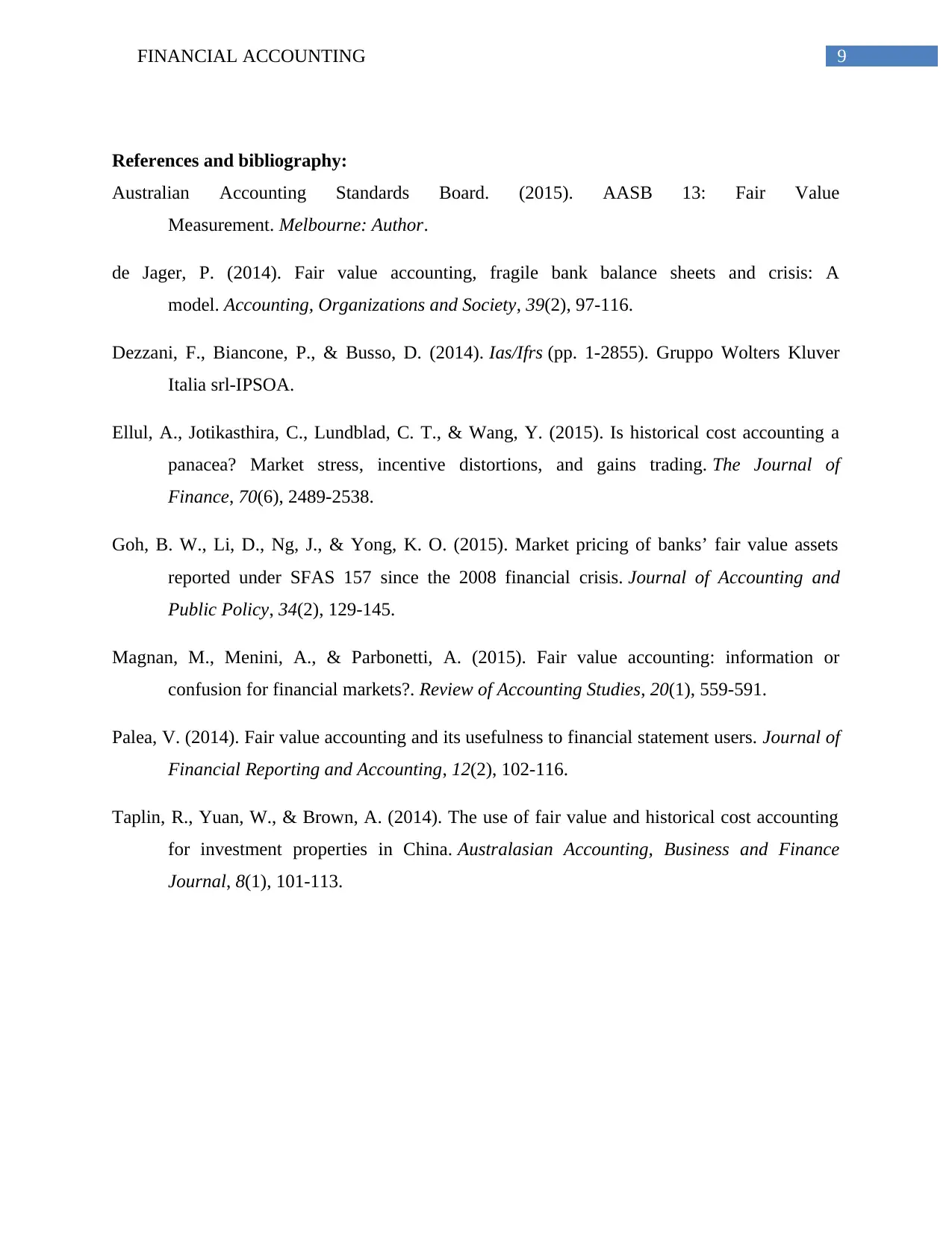
9FINANCIAL ACCOUNTING
References and bibliography:
Australian Accounting Standards Board. (2015). AASB 13: Fair Value
Measurement. Melbourne: Author.
de Jager, P. (2014). Fair value accounting, fragile bank balance sheets and crisis: A
model. Accounting, Organizations and Society, 39(2), 97-116.
Dezzani, F., Biancone, P., & Busso, D. (2014). Ias/Ifrs (pp. 1-2855). Gruppo Wolters Kluver
Italia srl-IPSOA.
Ellul, A., Jotikasthira, C., Lundblad, C. T., & Wang, Y. (2015). Is historical cost accounting a
panacea? Market stress, incentive distortions, and gains trading. The Journal of
Finance, 70(6), 2489-2538.
Goh, B. W., Li, D., Ng, J., & Yong, K. O. (2015). Market pricing of banks’ fair value assets
reported under SFAS 157 since the 2008 financial crisis. Journal of Accounting and
Public Policy, 34(2), 129-145.
Magnan, M., Menini, A., & Parbonetti, A. (2015). Fair value accounting: information or
confusion for financial markets?. Review of Accounting Studies, 20(1), 559-591.
Palea, V. (2014). Fair value accounting and its usefulness to financial statement users. Journal of
Financial Reporting and Accounting, 12(2), 102-116.
Taplin, R., Yuan, W., & Brown, A. (2014). The use of fair value and historical cost accounting
for investment properties in China. Australasian Accounting, Business and Finance
Journal, 8(1), 101-113.
References and bibliography:
Australian Accounting Standards Board. (2015). AASB 13: Fair Value
Measurement. Melbourne: Author.
de Jager, P. (2014). Fair value accounting, fragile bank balance sheets and crisis: A
model. Accounting, Organizations and Society, 39(2), 97-116.
Dezzani, F., Biancone, P., & Busso, D. (2014). Ias/Ifrs (pp. 1-2855). Gruppo Wolters Kluver
Italia srl-IPSOA.
Ellul, A., Jotikasthira, C., Lundblad, C. T., & Wang, Y. (2015). Is historical cost accounting a
panacea? Market stress, incentive distortions, and gains trading. The Journal of
Finance, 70(6), 2489-2538.
Goh, B. W., Li, D., Ng, J., & Yong, K. O. (2015). Market pricing of banks’ fair value assets
reported under SFAS 157 since the 2008 financial crisis. Journal of Accounting and
Public Policy, 34(2), 129-145.
Magnan, M., Menini, A., & Parbonetti, A. (2015). Fair value accounting: information or
confusion for financial markets?. Review of Accounting Studies, 20(1), 559-591.
Palea, V. (2014). Fair value accounting and its usefulness to financial statement users. Journal of
Financial Reporting and Accounting, 12(2), 102-116.
Taplin, R., Yuan, W., & Brown, A. (2014). The use of fair value and historical cost accounting
for investment properties in China. Australasian Accounting, Business and Finance
Journal, 8(1), 101-113.
1 out of 10